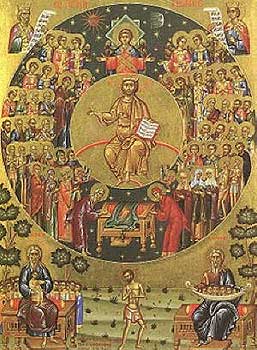
The Monk Ortesios (Orseses) Tabennisiotes (+ 380) was the successor of the Monk Pakhomias the Great (+ 348, Comm. 15 May). While still in his early years he attained to such a degree of spiritual experience, that the Monk Pakhomias entrusted to him the governance of the Khenobossa monastery. Once the Monk Pakhomias, conversing with his students, said about the Monk Ortesios: "I tell you, that Ortesios doth shine in the house of God, like a golden lamp". After the end of the Monk Pakhomias, Saint Ortesios against his will was chosen as head of the Tabennisiotan monks. To such a number did the brethren increase, that the Monk Ortesios appointed as his helper the Monk Theodore, and then gave over to him the complete rule of the monastery, while he himself withdrew to the Khenobossa monastery. Upon the death of Saint Theodore in the year 365, Sainted-bishop Athanasias the Great wrote to the Monk Ortesios and his brethren: "Beloved brethren, weep not for Theodore: he is not dead but asleep. No one should weep, but rather each should imitate him. It is not proper to weep for one, that hath gone over to a place without worries.. and to thee, dear and beloved Ortesios, I write: "since that he hath reposed, take upon thyself this care, replace him for the brethren. While yet he lived, ye were both as one". The Monk Ortesios fulfilled the will of Sainted Athanasias.
Abba Ortesios possessed a profound knowledge of holy Scripture and the gift of inspired words. "The power of his words, – said a contemporary, – it seems, grew in him to the solace of the brethren". "Ortesios, a man fully familiar with Holy Scripture, wrote a book, seasoned with spiritual salt, or to say, to explain almost all of the Old and New Testaments in short meditations for the needs of monks. He left it to the fathers together with his bequest before his death". The book was soon translated into the Greek language, and Blessed Jerome translated it into Latin. In the book of the Monk Ortesios there are two theses: a guide for the monastic life (translated into the Russian language in 1859) and a guide concerning six purposeful meditations.
Back

 The Monk Ortesios (Orseses) Tabennisiotes (+ 380) was the successor of the Monk Pakhomias the Great (+ 348, Comm. 15 May). While still in his early years he attained to such a degree of spiritual experience, that the Monk Pakhomias entrusted to him the governance of the Khenobossa monastery. Once the Monk Pakhomias, conversing with his students, said about the Monk Ortesios: "I tell you, that Ortesios doth shine in the house of God, like a golden lamp". After the end of the Monk Pakhomias, Saint Ortesios against his will was chosen as head of the Tabennisiotan monks. To such a number did the brethren increase, that the Monk Ortesios appointed as his helper the Monk Theodore, and then gave over to him the complete rule of the monastery, while he himself withdrew to the Khenobossa monastery. Upon the death of Saint Theodore in the year 365, Sainted-bishop Athanasias the Great wrote to the Monk Ortesios and his brethren: "Beloved brethren, weep not for Theodore: he is not dead but asleep. No one should weep, but rather each should imitate him. It is not proper to weep for one, that hath gone over to a place without worries.. and to thee, dear and beloved Ortesios, I write: "since that he hath reposed, take upon thyself this care, replace him for the brethren. While yet he lived, ye were both as one". The Monk Ortesios fulfilled the will of Sainted Athanasias.
The Monk Ortesios (Orseses) Tabennisiotes (+ 380) was the successor of the Monk Pakhomias the Great (+ 348, Comm. 15 May). While still in his early years he attained to such a degree of spiritual experience, that the Monk Pakhomias entrusted to him the governance of the Khenobossa monastery. Once the Monk Pakhomias, conversing with his students, said about the Monk Ortesios: "I tell you, that Ortesios doth shine in the house of God, like a golden lamp". After the end of the Monk Pakhomias, Saint Ortesios against his will was chosen as head of the Tabennisiotan monks. To such a number did the brethren increase, that the Monk Ortesios appointed as his helper the Monk Theodore, and then gave over to him the complete rule of the monastery, while he himself withdrew to the Khenobossa monastery. Upon the death of Saint Theodore in the year 365, Sainted-bishop Athanasias the Great wrote to the Monk Ortesios and his brethren: "Beloved brethren, weep not for Theodore: he is not dead but asleep. No one should weep, but rather each should imitate him. It is not proper to weep for one, that hath gone over to a place without worries.. and to thee, dear and beloved Ortesios, I write: "since that he hath reposed, take upon thyself this care, replace him for the brethren. While yet he lived, ye were both as one". The Monk Ortesios fulfilled the will of Sainted Athanasias.